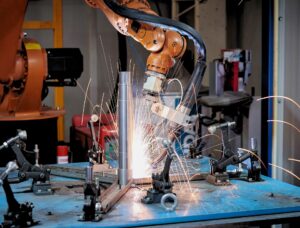Welding is more than just melting metal—it’s about choosing the right joint type to ensure strength, alignment, and structural integrity. Whether you’re working on a light fabrication project or a heavy-duty pipeline, selecting the right weld joint is one of the most critical decisions you’ll make. In this guide, we’ll break down the five most common welding joints are explained—Butt, Lap, T-Joint, Corner, and Edge—where and why they’re used. And with the help of welding cameras, you can monitor each joint in real-time for quality, alignment, and consistency.
1. Butt Joint
Description: Two metal pieces are aligned in the same plane and joined at their edges.
Common In:
- Pipe welding
- Sheet metal fabrication
- Structural steel work
Advantages:
- Simple and economical
- Easy to automate in robotic welding
- Ideal for full-penetration welds
Best Welding Methods: MIG welding, TIG welding, Plasma Arc Welding, Submerged Arc Welding (SAW)
Tip: Use a weld monitoring camera to track heat input and penetration depth, especially for thicker materials.
2. Lap Joint
Description: One metal piece is laid over another and welded along the edges.
Common In:
- Automotive bodywork
- Sheet metal applications
- Stainless steel and aluminum welding
Advantages:
- Good for joining dissimilar thicknesses
- More surface area for welding
- Reduces distortion in thin materials
Best Welding Methods: MIG and MAG welding, Laser Welding, Spot Welding
Pro Insight: Lap joints can trap moisture or contaminants. Use welding visual inspection tools before welding to avoid weld defects like porosity or slag inclusion.
3. T-Joint
Description: One metal piece is joined perpendicular to the middle of another, forming a “T” shape.
Common In:
- Structural frameworks
- Pipe supports
- Heavy fabrication and shipbuilding
Advantages:
- Provides strong mechanical support
- Can be fillet or groove welded
Best Welding Methods: Metal Arc Welding, MIG welding, TIG welding
Monitoring Tip: Real-time arc welding image feedback helps ensure proper fusion at the root and minimize undercutting.
4. Corner Joint
Description: Two pieces meet at a 90° angle, forming the outside corner of a box or frame.
Common In:
- Box frames
- Enclosures and cabinets
- Architectural steelwork
Advantages:
- Easy to align
- Versatile for both open and closed corners
Best Welding Methods: TIG Welding (Tungsten Inert Gas), MIG welding, Plasma Arc Welding
Pro Tip: Corner joints benefit from weld inspection using high-definition welding cameras to check fit-up before final welding.
5. Edge Joint
Description: Metal parts are placed side by side with edges touching and welded along the seam.
Common In:
- Sheet metal ducts
- Tank and vessel walls
- Automotive fabrication
Advantages:
- Minimal filler required
- Easy to prep and tack
Best Welding Methods: TIG Welding, MIG welding, Plasma Arc Welding
Operator Tip: Because edge joints are prone to burn-through, use a welding camera system to monitor heat input and travel speed.
Choosing the Right Welding Joint
Each joint has its own strengths and ideal applications. Here’s a quick comparison:
| Joint Type | Strength | Ease of Fit-Up | Best Use Case |
| Butt | High | Moderate | Pipes, plates |
| Lap | Moderate | Easy | Auto panels, light fab |
| T-Joint | High | Easy | Frames, structures |
| Corner | Moderate | Moderate | Boxes, containers |
| Edge | Low to Moderate | Easy | Sheet metal, HVAC |
Why Welding Cameras Matter for All Joint Types
Whether you’re a beginner or a pro, welding cameras and weld monitoring systems help improve:
✅ Alignment Accuracy
✅ Arc Stability
✅ Weld Quality Control
✅ Operator Training
Advanced welding inspection techniques with real-time visuals are especially helpful in confined areas, automated systems, or when working with aluminum or stainless steel, where reflectivity and contamination are challenges.
Conclusion: Common Welding Joints Explained
Knowing your welding joints is the first step toward making durable, precise, and safe welds. Combine the right welding technique with proper joint prep and real-time monitoring using a weld camera to reduce rework, increase efficiency, and deliver top-tier results.
Need help choosing the best camera for welding applications? Mecaweld offers tailored solutions for every industry—from fabrication to aerospace. Contact us today to learn more!



